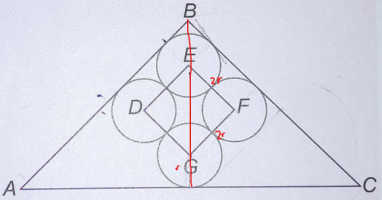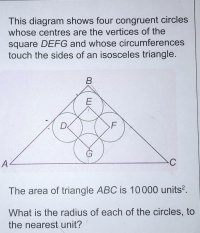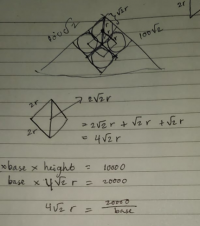circles in a triangle
- Thread starter nanase
- Start date
Dr.Peterson
Elite Member
- Joined
- Nov 12, 2017
- Messages
- 16,814
You seem to have several right ideas, but not have put them together correctly.I tried finding the height of the triangle first in terms of r, but not sure how to find the base. Or is there a different way to approach this? Thanks for guidance.
View attachment 33766
First, you know what kind of triangle this is, right? If you know the height, you also know the base. Your mention of 1002 implies you have thought of these ideas (though I don't think it will be useful in itself).
Second, your drawing doesn't show the bottom circle touching the base of the triangle, so some of your thinking is wrong.
Use this:

it is mentioned that the triangle is isosceles, but am I allowed to assume that the angle at B is right-angle?You seem to have several right ideas, but not have put them together correctly.
First, you know what kind of triangle this is, right? If you know the height, you also know the base. Your mention of 1002 implies you have thought of these ideas (though I don't think it will be useful in itself).
Second, your drawing doesn't show the bottom circle touching the base of the triangle, so some of your thinking is wrong.
Use this:
View attachment 33769
I am not sure about the value of 1002 since can't tell if it is right angle. I got that value "assuming" that triangle is half a square, but is that allowed?
I realise that the height of the triangle now is 32(r) + r, because there is no space after the botttom circle
Dr.Peterson
Elite Member
- Joined
- Nov 12, 2017
- Messages
- 16,814
No, you can't just assume; but you can conclude it based on a reason.it is mentioned that the triangle is isosceles, but am I allowed to assume that the angle at B is right-angle?
I am not sure about the value of 1002 since can't tell if it is right angle. I got that value "assuming" that triangle is half a square, but is that allowed?
I realise that the height of the triangle now is 32(r) + r, because there is no space after the bottom circle
You are told that DEF is a right angle. What can you conclude about ABC? Why?
If it's a right isosceles triangle, then ...I am tickled with "if you know the height, then you know the base"
how?
In particular, if you call the bottom end of my red line H, what kind of triangle is BHC? What is its area? What are BH and HC?
let me know if my reasoning is correct /not,
because DEF is a right angle, ABC must be a right angle too, because the formation of circles stacked neatly will ensure the angle on top of DEF must be right angle too.
and thus the value of 100sqrt(2) for the slope side is confirmed.
is my reasoning valid?
because DEF is a right angle, ABC must be a right angle too, because the formation of circles stacked neatly will ensure the angle on top of DEF must be right angle too.
and thus the value of 100sqrt(2) for the slope side is confirmed.
is my reasoning valid?
Please check if my calculations are correct.
for the base of the triangle I have 200
for the height I have 3sqrt(2)r + r
equating the area of the triangle to 10000, and solving for r as the subject, I have (rounded to the nearest unit) 19 unit as the answer
for the base of the triangle I have 200
for the height I have 3sqrt(2)r + r
equating the area of the triangle to 10000, and solving for r as the subject, I have (rounded to the nearest unit) 19 unit as the answer
Dr.Peterson
Elite Member
- Joined
- Nov 12, 2017
- Messages
- 16,814
Equivalently, the altitude is 100, and you can just solve (3sqrt(2)+1)r = 100. Your answer is correct.Please check if my calculations are correct.
for the base of the triangle I have 200
for the height I have 3sqrt(2)r + r
equating the area of the triangle to 10000, and solving for r as the subject, I have (rounded to the nearest unit) 19 unit as the answer
ah yes that's a different way of looking at it too! thanks so much for the help, sorry I ask a lot, I am not the brightest but really want to understand how things work mathematically!Equivalently, the altitude is 100, and you can just solve (3sqrt(2)+1)r = 100. Your answer is correct.
Thankkkk youuuuuu


